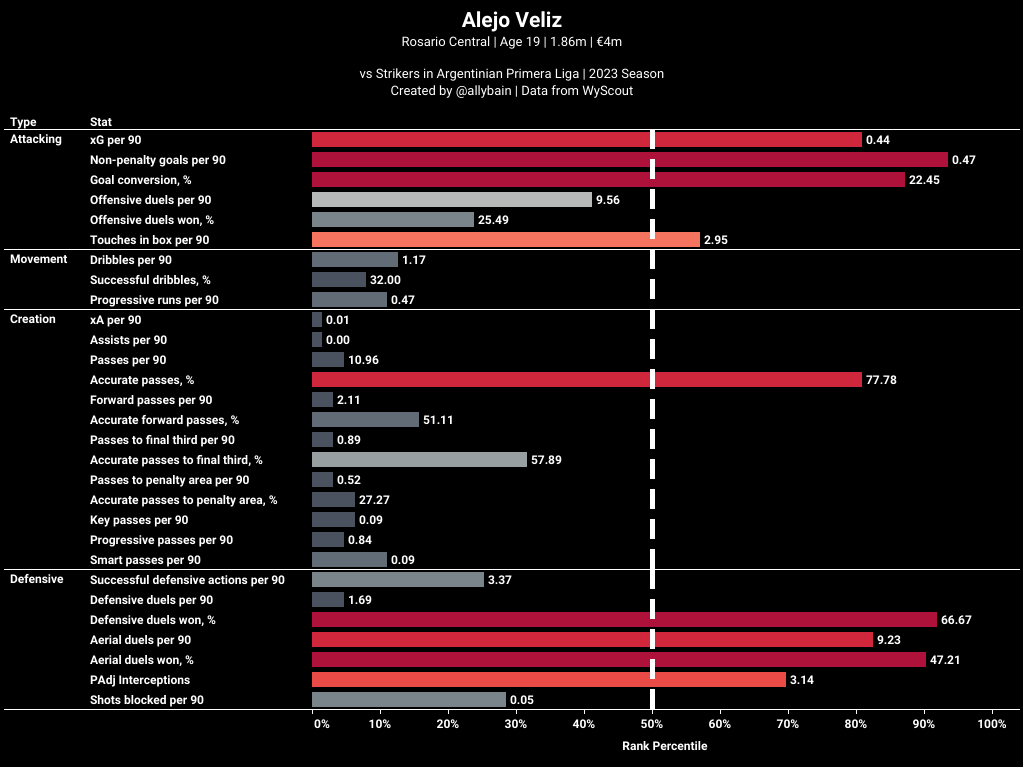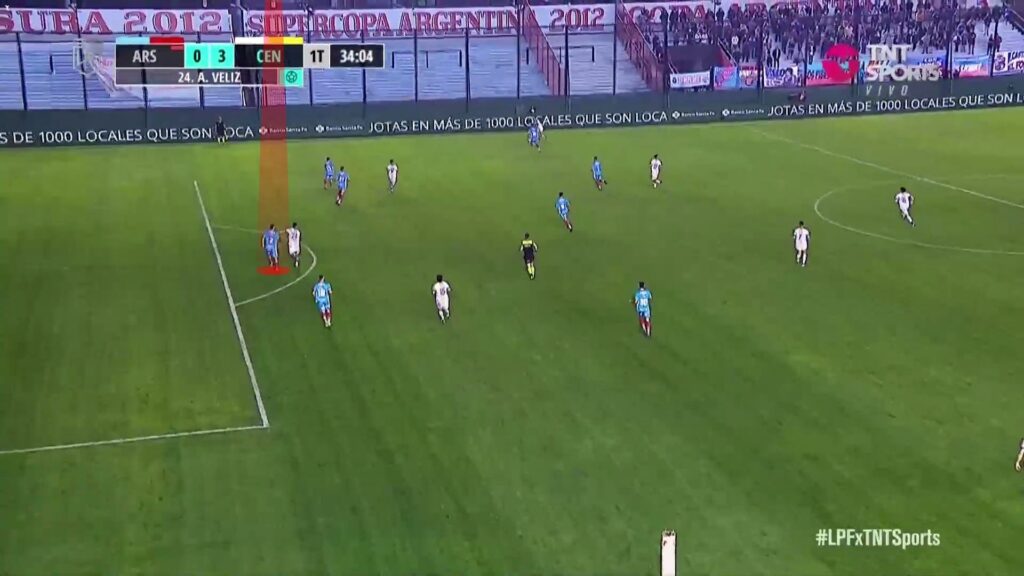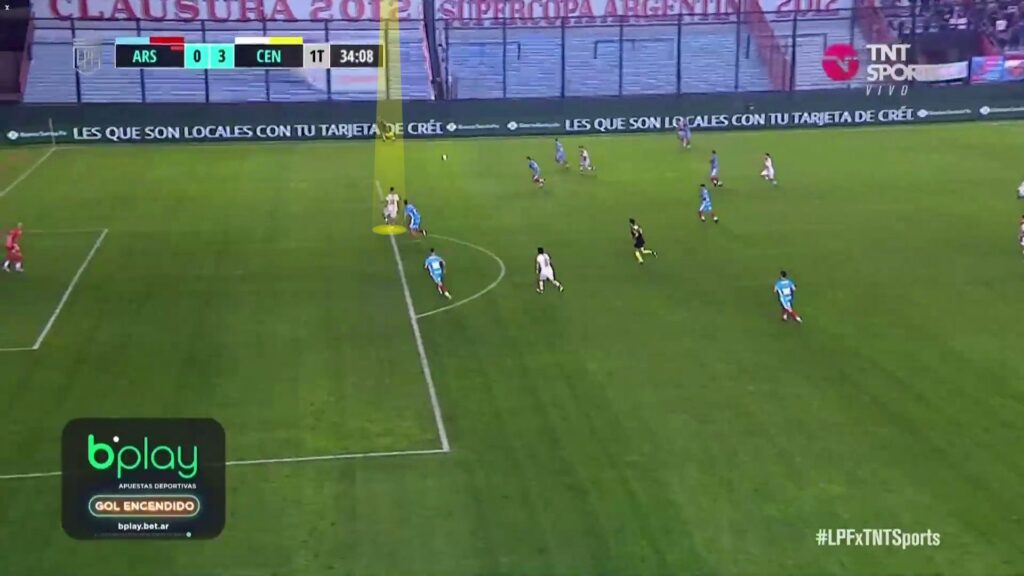This article will illustrate our video scouts’ process when building a scout report, taking a previously identified player and breaking down his strengths and weaknesses.
For this task, we have chosen to evaluate Alejo Veliz, who many consider a player of real potential. He has just completed his second full season as a prominent figure in Rosario Central’s attack, registering 17 goals across 53 matches during his time in the Primera División, all at the tender age of 19.
Data Report
When identifying players for our partners, we would initially use our profiling model to rank players against the performance of a particular subset of their peers. For instance, we list the top-performing strikers into Target Men, Deep Lying Forward, and Poacher profiles, with over 1000 minutes of play across specific competitions. In this case, we already know we are scouting Veliz, so when we consult the model, it shows us he ranks as the 5th best-performing target man in the Argentine Primera División.
- Javier Toledo – 37 – Sarmiento
- Pablo Vegetti – 34 – Belgrano
- Nicolas Cordero – 24 – Hurucan
- Marcelo Estigarribia – 28 – Atletico Tucuman
- Alejo Veliz – 19 – Rosario Central
This information gives us a mind’s eye view of what type of player he is, but our next step is to analyze his data in a bar chart, using rank percentile to identify which parts of the game he performs best.

While numbers don’t paint a complete picture, a quick deduction from his numbers would lead us to suggest the following:
- His xG per 90 and touches in the box suggest he operates in a side that works to create chances closer to the opposition goal, either through direct crosses or aggressive through passes.
- His Aerial Duels p/90 and Aerial Duels Won % show us that he is involved in a significant amount of 1v1 battles with his center-back opponent. This further illustrates that his team plays in a direct fashion, and he has the physicality to compete on that front.
- His PAdj Interceptions and Defensive Duels Won % speak to a forward that may not immediately press the ball but does his best work to win the second ball or counter press effectively.
So with these presumptions as to Veliz’s ability in mind, let’s look at his performance on video to form a more rounded opinion.
Technical Ability
When analyzing strikers, a great place to start is analyzing behaviors during the build-up to their goals.
It’s important to clarify this was Veliz first ever goal for Rosario Central. Even as a rookie at this level, he displayed impressive movement before receiving the ball.
Let’s break down the move step by step:
- As the ball reaches the wide player, Veliz immediately arcs his run to the blindside of the last defender. Stretching the central defender’s line of vision, Veliz forces him to drop back as his opponent attempts to maintain eye contact on the ball and see the striker’s run.
- Veliz stretches the space further by moving out to the full-back, who has now moved inside to assist his defensive partner.
- As the ball moves to the Rosario Central midfielder, the Huracan central defenders step up, but in the confusion of who should be picking up Veliz, the left back fails to step and presents a space for Veliz to attack.
- Veliz bends his run to stay onside, then explodes forward to accept the through pass.
- His first touch anticipates pressure from the goalkeeper, buying him a split second to prepare for a clinical finish at the front post.
Strikers run through these movements hundreds of times a week in training, but the difference in game-day execution stems from calmness in pressure situations. Veliz displays a very cool head here, and the look on his face tells you what this first goal means to him.
Facing the goal is one thing for a striker, but what about Veliz’s striking ability with his back to goal?
On a surface level, any shot that flies into the top corner looks visually impressive. It’s not until we see the replay that we better understand Veliz’s ability to buy himself some space and, crucially, time to prepare for the shot.



His understanding of how to delay his run until the ball reaches the winger, then get himself distance between his marker by pushing off and exposing the space, is just brilliant striker play. This buys him a half-yard of space to strike the ball under no pressure, allowing him to make contact using a fluid body motion.
Tactical Ability
To effectively analyze Veliz’s performance, we need to understand his specific role on the team and how successful he is performing it.
Miguel Angel Russo, Rosario Central’s vastly experienced manager in his fifth stint at the club, has implemented a 4-2-3-1 system that relies heavily on the interconnection between the front four. On the flanks are two dynamic inside forwards, Jaminton Campaz and Lautaro Giaccone, who work in service of Veliz but are equally capable of scoring independently. Underneath Veliz is the wily veteran Ignacio Malcorra, a highly creative player who is a master at creating chances in tight spaces.
So how does Veliz work within this team when he’s not in a shooting position?
Given how Rosario Central uses direct passes in the build-up, Veliz’s primary function when initiating an attack is to link with those in support of him by whatever means. Whether this is a chest pass, headed flick-on, or first-time set, the fluid movement of Campaz, Malcorra, and Giaccone relies on a quality first touch from Veliz.
In moments of transition, Veliz must delay an attack until support reaches him, which in the Argentine Primera Division his 1.86m and broad frame unquestionably come in handy.
Out of Possession
There is a pre-supposition that every striker has to press like a madman the second a ball enters play; however, we must return to a player’s role and function to assess performance when scouting.
There are two opposing situations Veliz performs his defensive actions. The first is more sedate, when he remains almost stationary in a central position, working as part of a defensive block that ushers play wide so Giaccone and Campaz can aggressively step to the ball. The more active defending Veliz conducts occurs in moments of transition.
We see in these clips that when a direct pass has been unsuccessful, Veliz comes to life as he sprints to press the defender’s touch, hunting down the ball to restart an attack.
Character
The last piece of the player scouting model is to use performance to identify behaviors. As I watch a player, I’ll frequently write down upward of 40 or 50 notes relating to what type of persona they exhibit on the field. When conducting the Veliz report, this was reduced to five:
- Combative
- Robust Defensive Actions
- Stands his Ground
- Respectful to Officials
- Connection with the Fans
This clip is a strong representation of these behaviors. For a young man, he certainly doesn’t back down from a confrontation, yet he also remains in control mentally, with the focus that he’s out there to perform well for the team.
Conclusion
Once we’ve combined the data and video reporting to help us shape an impression of a player, it’s at this point we must endeavor to maintain impartiality moving forward. Our understanding of a player’s ability comes from a gut feeling, but we cannot allow that to develop into confirmation bias during future scouting.
Our task in the identification process is to assess competency in their ability to complete their role; therefore, talent alone does not alleviate them from performing those responsibilities. By applying contextual factors such as the level of the opponent, game state, or team form, we better understand how performance fluctuates over a period of time.
If you’d like to expand your scouting network, contact us today, and our team of video analysts could help unearth your next top player. We specialize in recruitment within North and South America, with specific resources assessing talent in the USA, Mexico, Colombia, Uruguay, and Argentina.


